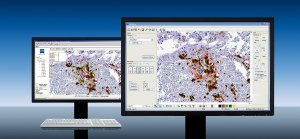Carl Zeiss has introduced the PALM VisDat (Virtual Slide Data Transfer) module of the PALM RoboSoftware, which makes it possible for the first time to connect molecular and digital pathology. The VisDat module enables users to precisely transfer information about specific areas marked on digitised tissue sections for laser microdissection on the Carl Zeiss PALM MicroBeam systems. This is particularly beneficial for researchers in molecular biology and medicine as well as for pathologists.
 The new VisDat (Virtual Slide Date Transfer) module of the PALM RoboSoftware makes it possible for the first time to connect molecular and digital pathology.
The new VisDat (Virtual Slide Date Transfer) module of the PALM RoboSoftware makes it possible for the first time to connect molecular and digital pathology.
Thanks to its intuitive user interface, the module is very easy to operate. Microscopic specimens are scanned with one of the Zeiss MIRAX systems and uploaded to a server database using the MDSD (MIRAX Digital Slide Desktop) module. The digital tissue sections can then be accessed remotely and regions of interest marked via the Internet. The VisDat module transfers the markings from the MDSD database to a laser microdissection system where the selected areas are isolated for subsequent molecular analysis. Accuracy in the transfer of the object coordinates is maximised due to the precise reference method of the software module.
The new module saves users time. Until now, microscopic analysis is needed to check if the specimens are important. Only then can an examination on the laser microdissection system be performed in order to mark regions of interest. With VisDat, this additional step is eliminated.
Another major benefit of the new software is that users are not tied to a single location. The connection between MDSD and VisDat makes it possible to access the digital images via the Internet and discuss them online in tele-consultation meetings before the data is sent to the PALM systems via a network connection.
Several users can select areas of interest in the tissue section simultaneously using colour-specific object markers. These are recognised by the PALM software and used for colour-coded separation into different collection vessels during the laser microdissection process.
The VisDat module can be integrated into all PALM systems featuring RoboSoftware 4.3.